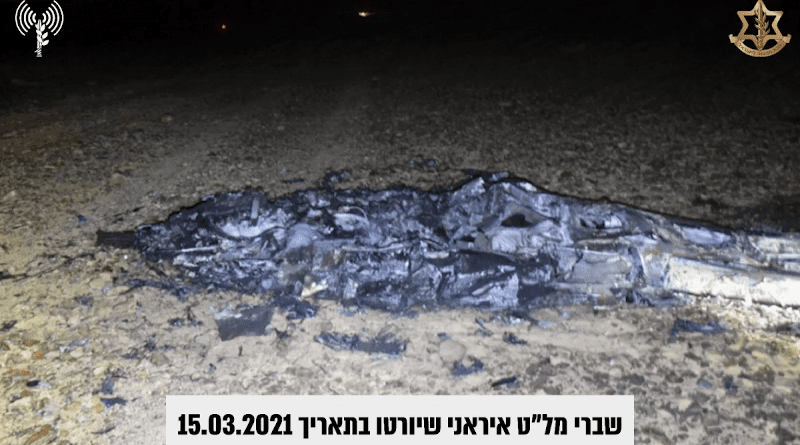First Israeli F-35 Interception Of Iranian Drones Happened Over Jordan With Its Approval – OpEd
Last year, Israel shot down Iranian drones which were transporting weapons to Gaza. Though we know Hezbollah and Iran have launched armed drones and surveillance drones into Israeli territory, this is the first time Iran has attempted to smuggle weapons to Gaza via drones.
It was also the first time a US-built F-35 was used to bring down a drone. But I should add that using an F-35, the most advanced warplane in the world, to bring down a lowly drone is like using a Ferrari to win a race against a turtle.
Iran’s tactic is a response to the usual complicated logistics of transporting weapons either by sea or land, where they can be intercepted by local or Israeli forces, as has often happened in the past in Lebanon, Syria, Sudan, and in the Red Sea. A drone is a fairly simple, low-cost, low-risk method of transport. It’s an example of the Iranians making a virtue of necessity. They have no F-35s. They have no aircraft carriers. They have no attack helicopters. But they have grit. They have technical skill. So they make the most of what they have.
Due to military censorship, an Israeli journalist provided a misleading report of the incident:
Israel says the interception took place before the UAVs could enter Israeli airspace. This means they were shot down over the airspace of at least one other country, although Israel did not identify which one that might be. Notably, Iran has flown drones from Syria into Israeli airspace before, in February 2018 and May 2021.
“The interception of the UAVs was carried out prior to them entering Israeli airspace, in coordination with neighboring countries.
…“According to the forensic investigation of the shrapnel, the [March 2021] UAVs were identified as the Iranian ‘Shahad 197′ on the way to transfer munition to…Hamas…
Despite the reference to Syria above, and the claim that Israel did not identify over which country the drone came down, an Israeli source reports to me that the Iranian drone was felled over Jordan and fell into Jordanian territory. Further, Israel received permission from the Jordanians for the IAF to do this. And the Jordanians collected the remains of the drone and shipped it to Israel. All this happened despite Jordan’s frigid relationship with Israel after the latter’s refusal to negotiate in good faith over Palestine, and Israel’s brutal suppression of Palestinians protesting restriction of Muslim worship at Haram al Sharif. While relations may be frosty on a political level, this incident proves that Jordan maintains close relations over strategic military affairs. This part of the story has been censored due to Jordanian sensitivity to being seen as an Israeli collaborator. Jordanians themselves would be angered to know that an Israeli war plane attacked a target within Jordan’s boundaries. It would remind them of their vulnerability to such attacks in the event of hostilities between the two countries.
This, of course, is not the first time Jordanian intelligence and military forces maintained such collaboration. As I wrote here years ago, when Palestinian civil engineer, Dirar Abussisi tried to escape Gaza via Jordan–where his family lived–on his way to exile in Ukraine, Jordanian intelligence officers detained him until Israel could prepare to kidnap him in Ukraine. After kidnapping him there, he was rendered unconscious and shipped in a coffin back to Israel, where he was wrongfully convicted of terror charges. He rots to this day in an Israeli prison because Hamas has refused to include him in previous prisoner exchanges with Israel.
This week over Israeli skies there was an enormous boom which sounded to many like an earthquake. It shook buildings and windows from Jerusalem to the far north. Israeli security services refuse to reveal the cause. But it may be noteworthy that PressTV reports that the IRG stated that two of its officers were killed early Monday morning in an Israeli strike over Damascus:
Iran’s Islamic Revolution Guards Corps (IRGC) vows to avenge the martyrdom of two of its advisors at the hands of the Israeli regime during a recent attack on the countryside of the Syrian capital Damascus.
…It named the two victims as Colonel Ehsan Karbalayi-Poor and Colonel Morteza Saeed-Nezhad, who were martyred following a missile attack by the Israeli regime on the outskirts of the Syrian capital a day earlier.
Given that the two dead were senior officers, it sounds like this was more of a targeted killing than one of the hundreds of past assaults on a Hezbollah military convoys or weapons storage facilities. In fact, Israeli reports say that the two men were leaders of a specialized engineering team improving the precision of drones. This explains why the IRG has responded with a vow of vengeance usually reserved for the killing of its more senior commanders. In that case, it would appear that Israel either intercepted communications which pinpointed their location, or had informants on the ground who did so.
Rumors abound in Israel that the earthquake-level shaking in Israel had nothing to do with a sonic boom, as the IDF reported. Rather, it was the result of the testing of a new bunker-busting bomb Israel is developing. While Israel does have less powerful US-supplied bunker busters, it does not have the most advanced 5,000-pound GBU-72. The US has refused to give it to Israel fearing, no doubt, that it could then independently attack Iran and take out its underground nuclear facilities such as those at Fordo. This may be Israel’s attempt to ensure it has similarly powerful weapons for attacking Iran, in case the US refusal continues.
This article was published at Tikun Olam

